In 1917 Konchalovsky receives clearing of military service and comes back to Moscow. He works much; writes still-lives, portraits, landscapes.
This year a still-life «Workbench» appears, documenting the constant aspiration of Konchalovsky to “self-service” in the field of art. He makes the stretchers, alters the frames, grounds canvases, mills paints. Heavy paint-milling machine is not the less necessary attribute of his studio then the easel…., , Konchalovsky has expressed in his «Workbench» all force of his love to the instruments of production of painter, after having been longing for painting during the long years of war. “
Nikolsky – …1936 – p. 66.
According to his own recognition, by the end of military service the artist has felt necessity of searching of new ways in painting. Together with family he goes to Crimea, to Sudak, and there – tries to write in a quite new manner.
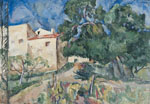
Sudak. Mulberry Tree. 1917
The most typical works of this period are: “The Model at an Oven”, written widely and generalized and the “In a Studio. A Family Portrait”.
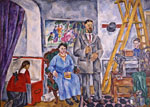
Family Portrait. 1917
“Drawing my daughter’s figure I felt like throwing a challenge to the life itself. How much I succeed in it is another matter, but that was what I wanted. I enjoyed the feeling that I am braiding a real plait of the living person when I was writing a plait in a portrait of my daughter. Enjoyed the thought that by means of nut color paint it is possible to braid almost real plait, to braid it so, that living hair will be felt in it… “.
Nikolsky – …1936 – p. 67.
His painting becomes not only spatial, but also airy.
1918 he spends in Moscow.
Right then the changes are defined which have occurred in painting of the artist. The attitude to the color and light obviously changes; the atmosphere of pictures becomes airy. The epoch of “conquest of color and air” begins.
It is possible to name the works: “The Station Nara”, “River”, “The Bridge in Nara” as the samples of landscapes reflecting the changes occurred.
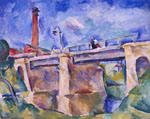
Bridge in Nara. Wind. 1918
The forms are still laconic and simplified. However, the movement of air now is opposed to the stasis of architectural forms.
“The wind tears the clouds running in the sky, brutally shakes a lantern on the bridge, is ready to dump into the river the woman going along the bridge. The immobility of factory pipe heavily perching up only emphasizes and strengthens the general dynamism of the landscape “.
Nikolsky – …1936 – p.69
In the same 1918, Konchalovsky writes his “The Violinist”, the first portrait in his creativity where the human figure is not static but is in movement.
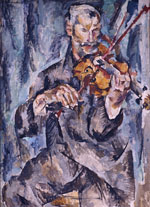
Portrait of the Violinist G. Romashkov. 1918
The artist declares, that the portrait became a turning-point in his painting; he was attracted before by “a substantial being” in the nature but now his task was to transfer the spiritualized condition of the musician.
“Clearly feeling the mathematics and geometry in Bach’s music I wished to construct the portrait as a kind of geometrical figure. Musical sounds somehow transformed themselves into the painted planes on a canvas; the most insignificant musical hints opened the deepest truths of painting.”
Quotation by Nikolsky – …1936 – p.70
The development of airy and light-bringing painting continues for the following years.
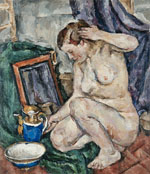
Squatting Model. 1919
In 1919 the artist writes a new series of works: four portraits, some landscapes and a number of still-lives. It is characteristic for these works the light colors scale of palette and silver-ashy pastel tones.
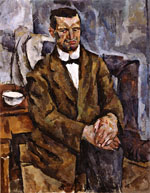
Portrait of the Sculptor P. Bromirsky. 1919
Now he constructs the composition of still-lives more freely and easily, the space breathes, and represented subjects are more realistic than before.
The artist continues solving a problem of transferring a moving body, and also studies the means of painting a person in the nature.
The landscapes of 1919 reflect Konchalovsky’s interest to motives of the nature of Moscow region, earlier met in his works only incidentally. The artist decides to spent the summer of the next year in Abramtzevo where writes an Abramtzevo oak grove and rural landscapes.
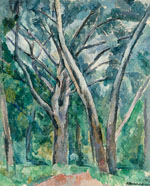
Silvery Poplars. 1919
P. Konchalovsky characterizes so the works of this period:
“In my Abramtzevo oaks there is still, certainly, a coherence of painting to Cezanne’s methods, which I have got used to work with and to which I felt the relationship. But my attitude to the nature now was another. My desire was passionate to create a living landscape, in which the trees would not stick up being simply stuck into the ground as it could be seen often in modern painting, but logically grow from the ground, as those of old masters. The spectator could feel their roots. And for this purpose it was necessary first of all to construct logically each tree, as they construct the building, from the base up to the roof, from the roots which had deeply grown into the ground up to the foliage of tops. / … / before to begin working, to choose finally a place, I wandered in the grove for hours, peered, studied all details. / … / the most important in a wood landscape for me is a silhouette of a tree against the sky, a silhouette of its branches. Old great masters could perfectly do such things, but imitators have turned the fine method into a “trick” of craft and, against my will, I was forced to go through the nature to classics as Cezanne had taught”.
Nikolsky – …1936 – p.78-79
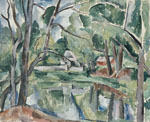
Pond. 1920
Except for the number of studies of an oak grove, in 1920 Konchalovsky writes some portraits and still-lives; however the landscape takes a prevailing place in its creativity for a long time.
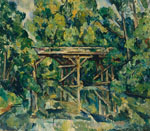
Bridge. 1920
Konchalovsky continues working in the summer of 1921 in Abramtzevo. Now he is interested not only with a day time solar landscape, but also with dawns, twilight, fogs («The Landscape with the Moon», «Twilight»).
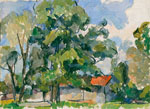
Near the Barn. 1921
He continues working on transferring an image of the nude body in the nature. The artist tries to insert a naked figure into a landscape so, that there would not be felt any artificial connection, trying to reach the integrity and uniformity of a composition. In connection with these searches he addresses to a theme of “bathing” and writes a series of works with the images of bathing people («Female Bathers» and « The Boys Bathing »).
However at that period, the landscape still appears subordinated to a figure, and compositions do not satisfy the artist, being written too solemnly and monumentally. Ever since, an image of the naked body in the nature becomes one of the constant phenomena in the painting of the master.
It is known, that in 1920-1921 the master again, after a long break, comes back to theatrical decoration and scenery. He carries out the scenery for the State Academic Bolshoy Theatre and makes sketches of the scenery and the suits for Bize’s “Carmen”. In 1921 he creates the scenery for an operetta of Offenbach – “Pericolla”, for Stanislavsky and Nemirovich-Danchenko musical Theatre.